Reference Functions
Introduction
In mathematics, reference functions are fundamental building blocks that help us understand more complex relationships. This chapter explores the following functions:
- Square Function: \(f(x) = x^2\)
- Square Root Function: \(f(x) = \sqrt{x}\)
- Cube Function: \(f(x) = x^3\)
- Inverse Function: \(f(x) = \frac{1}{x}\)
Square Function
Definition square function
The square function is given by \(f(x) = x^2\). This means that each input value \(x\) is multiplied by itself to give the output.

- Domain: All real numbers (\(\mathbb{R}\))
- Shape: A parabola opening upwards.
Proposition Properties
- For any real number \(x\), \(x^2 \geqslant 0\).
- The square function is strictly decreasing on \((-\infty, 0]\) and strictly increasing on \([0, +\infty)\).

- The square function is even (its graph is symmetric with respect to the \(y\)-axis).
Let \(f(x) = x^2\).
- The product of two real numbers with the same sign is positive, so \(x^2 = x \times x\) is positive.
- $$\begin{aligned}[t]f(-x) &= (-x)^2 \\ &= (-x) \times (-x) \\ &= x^2 \\ &= f(x).\end{aligned}$$Thus, \(f\) is even.
- Let \(a\) and \(b\) be two real numbers such that \(0 \leqslant a < b\).$$\begin{aligned}[t]f(b) - f(a) &= b^2 - a^2 \\ &= (b - a)(b + a) \\ &> 0 &\text{since }(b - a) > 0 \text{ and } (b + a) > 0.\end{aligned}$$Thus, \(f(a) < f(b)\). Therefore, \(f\) is strictly increasing on \([0, +\infty)\).
- Let \(a\) and \(b\) be two real numbers such that \(a < b \leqslant 0\).$$\begin{aligned}[t]f(b) - f(a) &= b^2 - a^2 \\ &= (b - a)(b + a) \\ &< 0 &\text{car } (b - a) > 0 \text{ and } (b + a) < 0.\end{aligned}$$Thus, \(f(a) > f(b)\). Therefore, \(f\) is strictly decreasing on \((-\infty, 0]\).
Example
A square has a side length \(x\) meters. Its area is given by \(A(x) = x^2\). 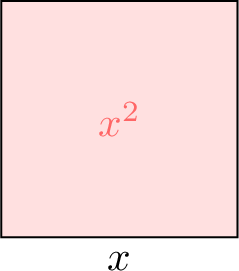
For example, for \(x = 4\) meters, \(A(4) = 4^2 = 16\) square meters.

Square Root Function
Definition Square Root Function
The square root function is given by \(f(x) = \sqrt{x}\). It is the inverse of the square function, where the output is the non-negative value that, when squared, gives the input.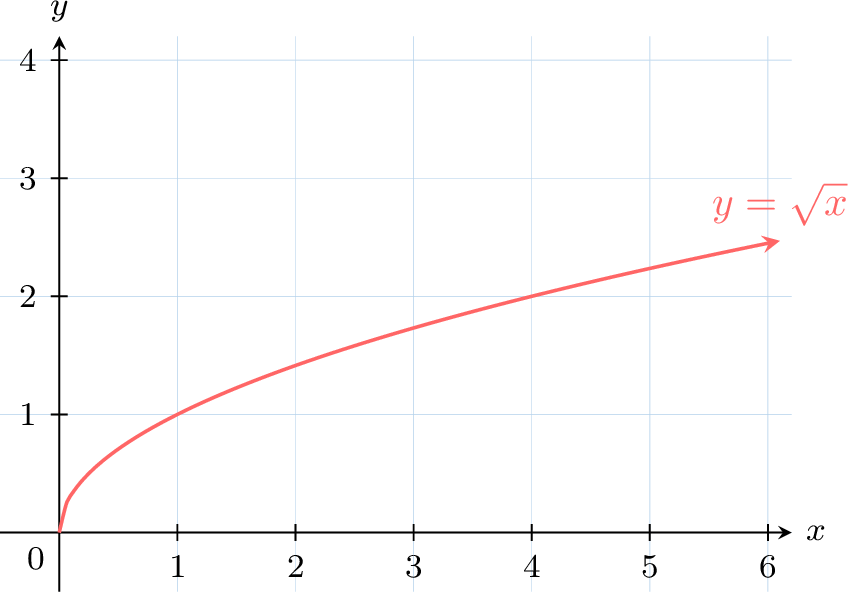

- Domain: \([0, +\infty)\) (non-negative real numbers)
- Shape: A curve that increases rapidly for small \(x\) and more slowly as \(x\) grows.
Proposition Properties
The square root function is strictly increasing on \([0, +\infty)\).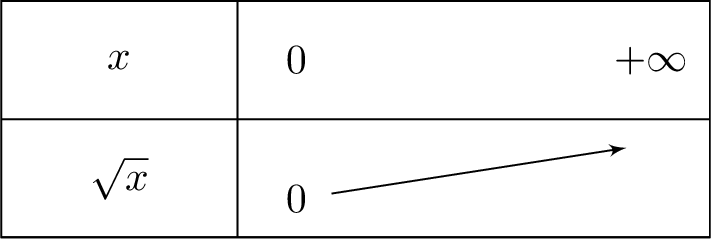

Let \(f(x) = \sqrt{x}\).
Let \(a\) and \(b\) be two real numbers such that \(0 \leqslant a < b\).$$\begin{aligned}[t]f(b) - f(a) &= \sqrt{b} - \sqrt{a} \\ &= \frac{(\sqrt{b} - \sqrt{a})(\sqrt{a} + \sqrt{b})}{\sqrt{a} + \sqrt{b}} \\ &= \frac{\left(\sqrt{b}\right)^2 - \left(\sqrt{a}\right)^2}{\sqrt{a} + \sqrt{b}} \\ &= \frac{b - a}{\sqrt{a} + \sqrt{b}} \\ &> 0 &\text{since }b - a > 0 \text{ and } \sqrt{a} + \sqrt{b} > 0.\end{aligned}$$Thus, \(f(a) < f(b)\).
The square root function is strictly increasing on \([0, +\infty)\).
Let \(a\) and \(b\) be two real numbers such that \(0 \leqslant a < b\).$$\begin{aligned}[t]f(b) - f(a) &= \sqrt{b} - \sqrt{a} \\ &= \frac{(\sqrt{b} - \sqrt{a})(\sqrt{a} + \sqrt{b})}{\sqrt{a} + \sqrt{b}} \\ &= \frac{\left(\sqrt{b}\right)^2 - \left(\sqrt{a}\right)^2}{\sqrt{a} + \sqrt{b}} \\ &= \frac{b - a}{\sqrt{a} + \sqrt{b}} \\ &> 0 &\text{since }b - a > 0 \text{ and } \sqrt{a} + \sqrt{b} > 0.\end{aligned}$$Thus, \(f(a) < f(b)\).
The square root function is strictly increasing on \([0, +\infty)\).
Example
Let a square have an area of \(x\) square meters. The length of the side of the square is \(l(x) = \sqrt{x}\). 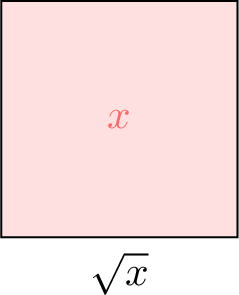
For example, for \(x = 25\) square meters, \(l(x) = \sqrt{25} = 5\) meters.

Cube Function
Definition Cube Function
The cube function is given by \(f(x) = x^3\).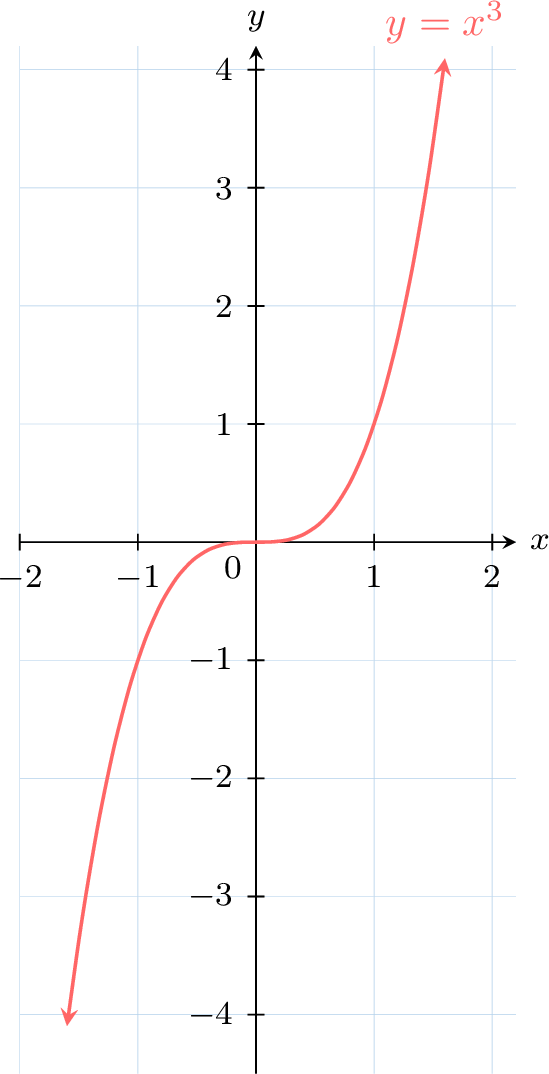

Proposition Properties
- The cube function is strictly increasing on \((-\infty, +\infty)\).
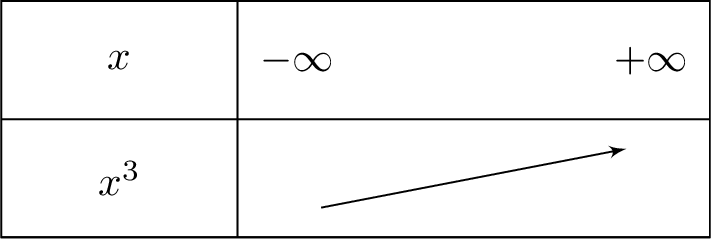
- The cube function is odd (its graph is symmetric symmetric about the origin).
Let \(f(x) = x^3\).
- $$\begin{aligned}[t]f(-x) &= (-x)^3 \\ &= (-x) \times (-x) \times (-x) \\ &= -(x \times x \times x) \\ &= -x^3 \\ &= -f(x).\end{aligned}$$Thus, \(f\) is odd.
- The proof of the variation of the cube function will be done using the derivative tool.
Example
The volume of a cube with a side length \(x\) meters is \(V(x) = x^3\).

Inverse Function
Definition Inverse Function
The inverse Function is given by \(f(x) = \dfrac{1}{x}\). It represents a reciprocal relationship, where the output is the reciprocal of the input.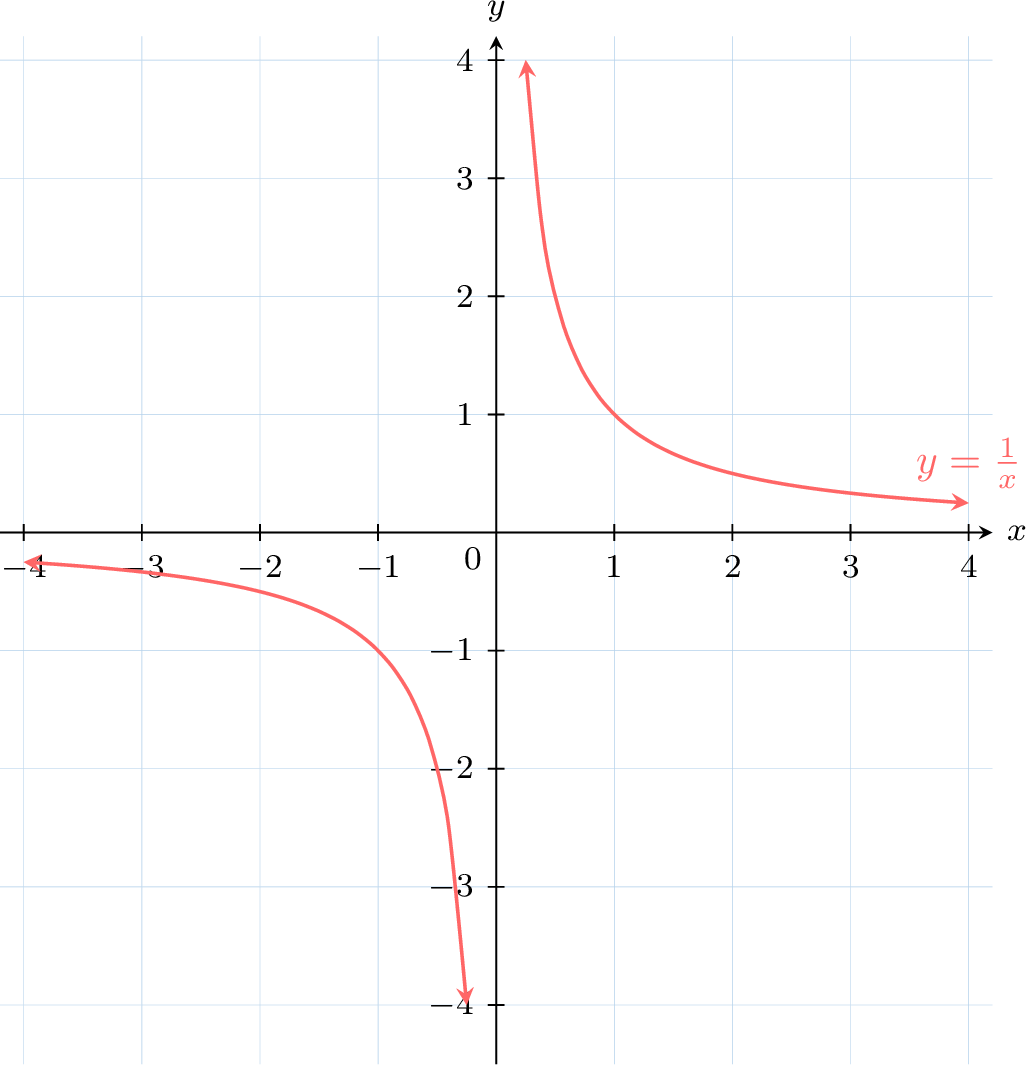

- Domain: \(\R^*\) (\(x \neq 0\))
- Shape: a hyperbola.
Proposition Properties
- The inverse function is strictly decreasing on \((-\infty, 0)\) and strictly decreasing on \((0, +\infty)\).

- The inverse function is odd (its graph is symmetric symmetric about the origin).
Let \(f(x)=\frac{1}{x}\)
- $$\begin{aligned}[t]f(-x) &= \frac{1}{-x} \\ &= -\frac{1}{x} \\ &= -f(x).\end{aligned}$$Thus, \(f\) is odd.
- Let \(a\) and \(b\) be two real numbers such that \(0 < a < b\).$$\begin{aligned}[t]f(b) - f(a) &= \dfrac{1}{b} - \dfrac{1}{a} \\ &= \dfrac{a - b}{ba} \\ &< 0 &\text{since } a - b < 0 \text{ and } ba > 0.\end{aligned}$$Thus, \(f(a) > f(b)\).
Therefore, \(f\) is strictly decreasing on \((0, +\infty)\). - Similarly, the proof is identical to show that \(f\) is strictly decreasing on \((-\infty, 0)\).
- Let \(a\) and \(b\) be two real numbers such that \(0 < a < b\).$$\begin{aligned}[t]f(b) - f(a) &= \dfrac{1}{b} - \dfrac{1}{a} \\ &= \dfrac{a - b}{ba} \\ &< 0 &\text{since } a - b < 0 \text{ and } ba > 0.\end{aligned}$$Thus, \(f(a) > f(b)\).